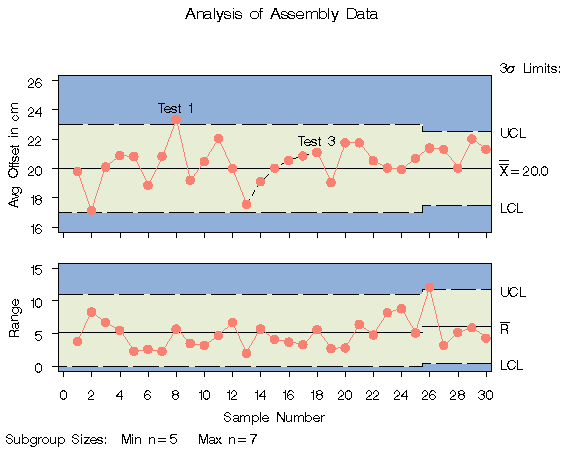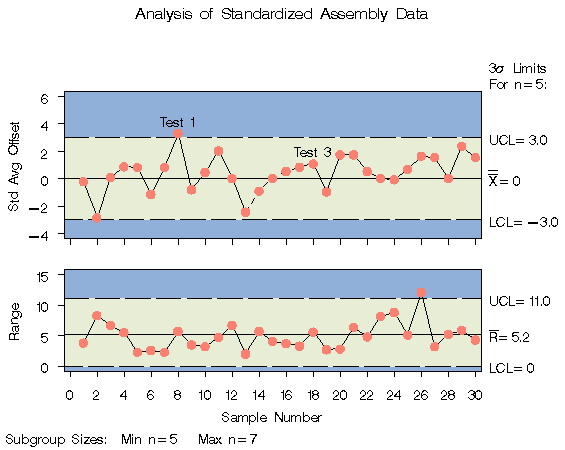Chapter Contents
Previous
Next
|
Chapter Contents |
Previous |
Next |
| Tests for Special Causes |
| See SHWTSC1 in the SAS/QC Sample Library |
Nelson (1989, 1994) describes the use of standardization to
apply the
tests for special causes to data involving varying subgroup samples.
This approach applies the tests to the standardized subgroup
statistics, setting the control limits at ![]() and the zone
boundaries at
and the zone
boundaries at ![]() and
and ![]() .For instance, for an
.For instance, for an ![]() chart with subgroup means
chart with subgroup means
![]() and
varying subgroup sample sizes
ni, the tests are applied to the standardized values
and
varying subgroup sample sizes
ni, the tests are applied to the standardized values
![]() ,where
,where ![]() estimates the process mean,
and s estimates the process standard deviation.
You can request this method with the TESTNMETHOD=
option,*
as illustrated by the following statements:
estimates the process mean,
and s estimates the process standard deviation.
You can request this method with the TESTNMETHOD=
option,*
as illustrated by the following statements:
symbol v=dot c=salmon;
title 'Analysis of Assembly Data';
proc shewhart history=assembly;
xrchart offset * sample / mu0 = 20
sigma0 = 2.24
tests = 1 to 4
testnmethod = standardize
testlabel = space
ltests = 2
vaxis = 16 to 26 by 2
split = '/'
cinfill = ywh
cframe = vligb
cconnect = salmon
ctests = black;
label offsetx = 'Avg Offset in cm/Range';
run;

|
The following statements create an equivalent chart that plots the standardized means:
data assembly;
set assembly;
zx = ( offsetx - 20 ) / ( 2.24 / sqrt( offsetn ) );
run;
symbol v=dot c=salmon;
title 'Analysis of Standardized Assembly Data';
proc shewhart
history=assembly (rename = (offsetr=zr offsetn=zn));
xrchart z * sample / mu0 = 0
sigma0 = 2.2361 /* sqrt 5 */
limitn = 5
alln
tests = 1 to 4
testlabel = space
ltests = 2
vaxis = -4 to 6 by 2
split = '/'
cinfill = ywh
cframe = vligb
cconnect = salmon
ctests = black;
label zx = 'Std Avg Offset/Range';
run;
Here, the SIGMA0= value is the square root
of the LIMITN= value.
The chart is shown in Figure 48.5.

|
Note: In situations where the standard deviation is estimated from the data and the subgroup sample sizes vary, you can use the SMETHOD= option to request various estimation methods, including the method of Burr (1969).
|
Chapter Contents |
Previous |
Next |
Top |
Copyright © 1999 by SAS Institute Inc., Cary, NC, USA. All rights reserved.